Pablo Mesejo
DaSCI research institute, DECSAI, University of Granada, Granada, Spain
Don't Forget your Inverse DDIM for Image Editing
May 14, 2025Abstract:The field of text-to-image generation has undergone significant advancements with the introduction of diffusion models. Nevertheless, the challenge of editing real images persists, as most methods are either computationally intensive or produce poor reconstructions. This paper introduces SAGE (Self-Attention Guidance for image Editing) - a novel technique leveraging pre-trained diffusion models for image editing. SAGE builds upon the DDIM algorithm and incorporates a novel guidance mechanism utilizing the self-attention layers of the diffusion U-Net. This mechanism computes a reconstruction objective based on attention maps generated during the inverse DDIM process, enabling efficient reconstruction of unedited regions without the need to precisely reconstruct the entire input image. Thus, SAGE directly addresses the key challenges in image editing. The superiority of SAGE over other methods is demonstrated through quantitative and qualitative evaluations and confirmed by a statistically validated comprehensive user study, in which all 47 surveyed users preferred SAGE over competing methods. Additionally, SAGE ranks as the top-performing method in seven out of 10 quantitative analyses and secures second and third places in the remaining three.
A Roadmap to Guide the Integration of LLMs in Hierarchical Planning
Jan 14, 2025Abstract:Recent advances in Large Language Models (LLMs) are fostering their integration into several reasoning-related fields, including Automated Planning (AP). However, their integration into Hierarchical Planning (HP), a subfield of AP that leverages hierarchical knowledge to enhance planning performance, remains largely unexplored. In this preliminary work, we propose a roadmap to address this gap and harness the potential of LLMs for HP. To this end, we present a taxonomy of integration methods, exploring how LLMs can be utilized within the HP life cycle. Additionally, we provide a benchmark with a standardized dataset for evaluating the performance of future LLM-based HP approaches, and present initial results for a state-of-the-art HP planner and LLM planner. As expected, the latter exhibits limited performance (3\% correct plans, and none with a correct hierarchical decomposition) but serves as a valuable baseline for future approaches.
Towards a Unified Framework for Sequential Decision Making
Oct 03, 2023Abstract:In recent years, the integration of Automated Planning (AP) and Reinforcement Learning (RL) has seen a surge of interest. To perform this integration, a general framework for Sequential Decision Making (SDM) would prove immensely useful, as it would help us understand how AP and RL fit together. In this preliminary work, we attempt to provide such a framework, suitable for any method ranging from Classical Planning to Deep RL, by drawing on concepts from Probability Theory and Bayesian inference. We formulate an SDM task as a set of training and test Markov Decision Processes (MDPs), to account for generalization. We provide a general algorithm for SDM which we hypothesize every SDM method is based on. According to it, every SDM algorithm can be seen as a procedure that iteratively improves its solution estimate by leveraging the task knowledge available. Finally, we derive a set of formulas and algorithms for calculating interesting properties of SDM tasks and methods, which make possible their empirical evaluation and comparison.
A Review of Symbolic, Subsymbolic and Hybrid Methods for Sequential Decision Making
Apr 20, 2023Abstract:The field of Sequential Decision Making (SDM) provides tools for solving Sequential Decision Processes (SDPs), where an agent must make a series of decisions in order to complete a task or achieve a goal. Historically, two competing SDM paradigms have view for supremacy. Automated Planning (AP) proposes to solve SDPs by performing a reasoning process over a model of the world, often represented symbolically. Conversely, Reinforcement Learning (RL) proposes to learn the solution of the SDP from data, without a world model, and represent the learned knowledge subsymbolically. In the spirit of reconciliation, we provide a review of symbolic, subsymbolic and hybrid methods for SDM. We cover both methods for solving SDPs (e.g., AP, RL and techniques that learn to plan) and for learning aspects of their structure (e.g., world models, state invariants and landmarks). To the best of our knowledge, no other review in the field provides the same scope. As an additional contribution, we discuss what properties an ideal method for SDM should exhibit and argue that neurosymbolic AI is the current approach which most closely resembles this ideal method. Finally, we outline several proposals to advance the field of SDM via the integration of symbolic and subsymbolic AI.
A Survey on Semi-Supervised Semantic Segmentation
Feb 20, 2023Abstract:Semantic segmentation is one of the most challenging tasks in computer vision. However, in many applications, a frequent obstacle is the lack of labeled images, due to the high cost of pixel-level labeling. In this scenario, it makes sense to approach the problem from a semi-supervised point of view, where both labeled and unlabeled images are exploited. In recent years this line of research has gained much interest and many approaches have been published in this direction. Therefore, the main objective of this study is to provide an overview of the current state of the art in semi-supervised semantic segmentation, offering an updated taxonomy of all existing methods to date. This is complemented by an experimentation with a variety of models representing all the categories of the taxonomy on the most widely used becnhmark datasets in the literature, and a final discussion on the results obtained, the challenges and the most promising lines of future research.
NeSIG: A Neuro-Symbolic Method for Learning to Generate Planning Problems
Jan 24, 2023Abstract:In the field of Automated Planning there is often the need for a set of planning problems from a particular domain, e.g., to be used as training data for Machine Learning or as benchmarks in planning competitions. In most cases, these problems are created either by hand or by a domain-specific generator, putting a burden on the human designers. In this paper we propose NeSIG, to the best of our knowledge the first domain-independent method for automatically generating planning problems that are valid, diverse and difficult to solve. We formulate problem generation as a Markov Decision Process and train two generative policies with Deep Reinforcement Learning to generate problems with the desired properties. We conduct experiments on several classical domains, comparing our method with handcrafted domain-specific generators that generate valid and diverse problems but do not optimize difficulty. The results show NeSIG is able to automatically generate valid problems of greater difficulty than the competitor approaches, while maintaining good diversity.
A Survey on Evolutionary Computation for Computer Vision and Image Analysis: Past, Present, and Future Trends
Sep 14, 2022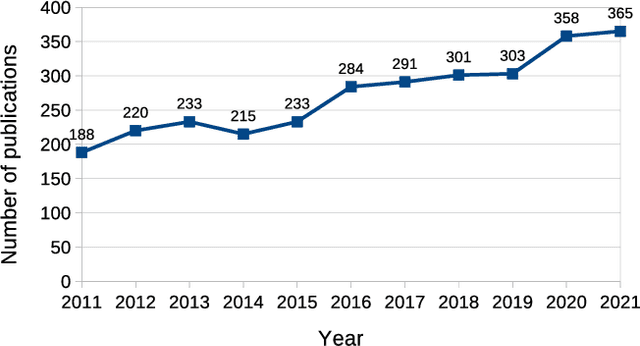
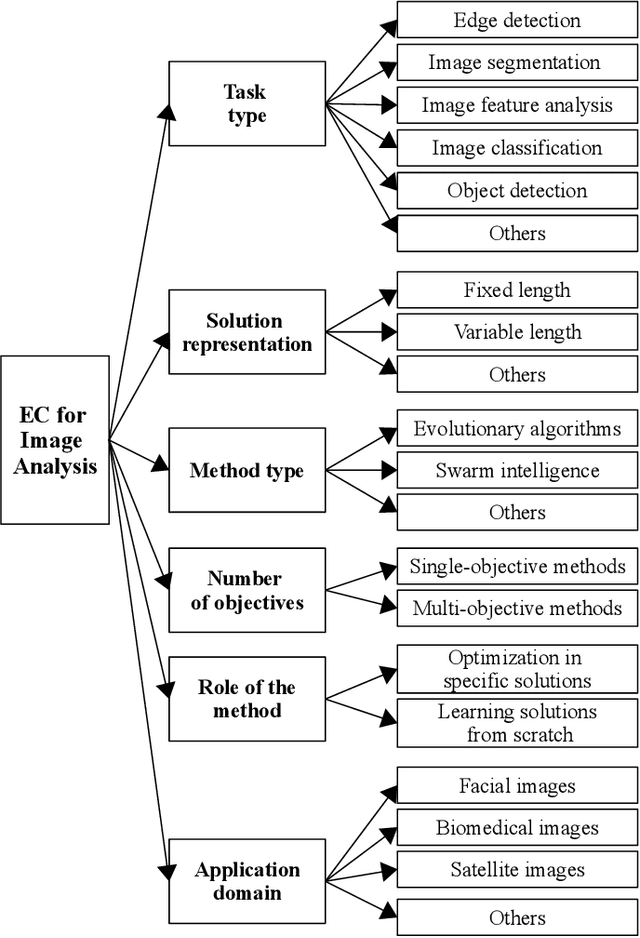


Abstract:Computer vision (CV) is a big and important field in artificial intelligence covering a wide range of applications. Image analysis is a major task in CV aiming to extract, analyse and understand the visual content of images. However, image-related tasks are very challenging due to many factors, e.g., high variations across images, high dimensionality, domain expertise requirement, and image distortions. Evolutionary computation (EC) approaches have been widely used for image analysis with significant achievement. However, there is no comprehensive survey of existing EC approaches to image analysis. To fill this gap, this paper provides a comprehensive survey covering all essential EC approaches to important image analysis tasks including edge detection, image segmentation, image feature analysis, image classification, object detection, and others. This survey aims to provide a better understanding of evolutionary computer vision (ECV) by discussing the contributions of different approaches and exploring how and why EC is used for CV and image analysis. The applications, challenges, issues, and trends associated to this research field are also discussed and summarised to provide further guidelines and opportunities for future research.
* Conditionally accepted by IEEE Transactions on Evolutionary Computation
Custom Structure Preservation in Face Aging
Jul 22, 2022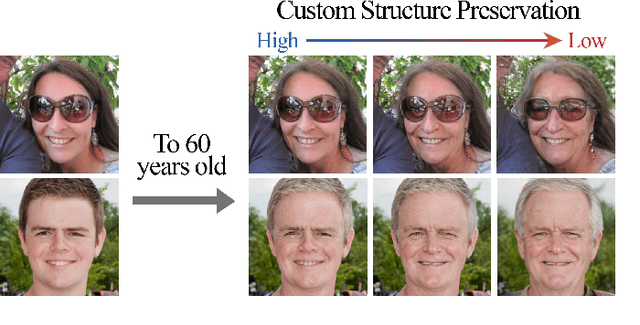
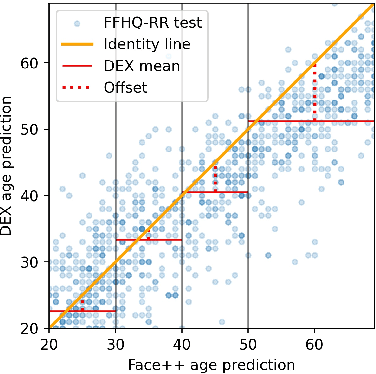
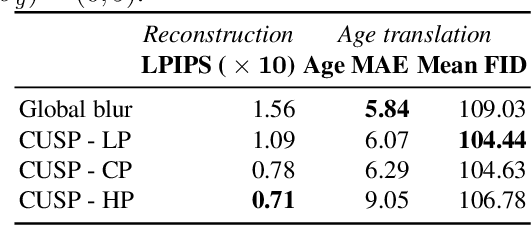
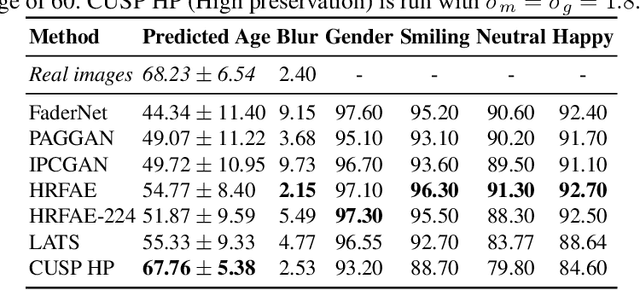
Abstract:In this work, we propose a novel architecture for face age editing that can produce structural modifications while maintaining relevant details present in the original image. We disentangle the style and content of the input image and propose a new decoder network that adopts a style-based strategy to combine the style and content representations of the input image while conditioning the output on the target age. We go beyond existing aging methods allowing users to adjust the degree of structure preservation in the input image during inference. To this purpose, we introduce a masking mechanism, the CUstom Structure Preservation module, that distinguishes relevant regions in the input image from those that should be discarded. CUSP requires no additional supervision. Finally, our quantitative and qualitative analysis which include a user study, show that our method outperforms prior art and demonstrates the effectiveness of our strategy regarding image editing and adjustable structure preservation. Code and pretrained models are available at https://github.com/guillermogotre/CUSP.
Learning Visual Voice Activity Detection with an Automatically Annotated Dataset
Oct 16, 2020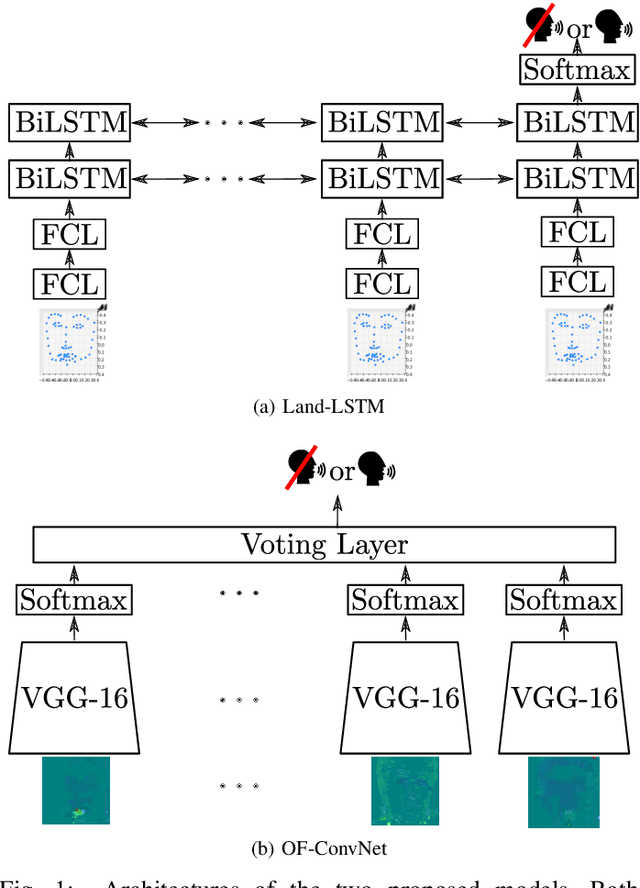

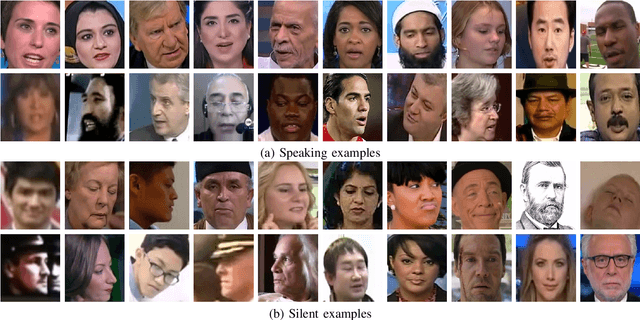
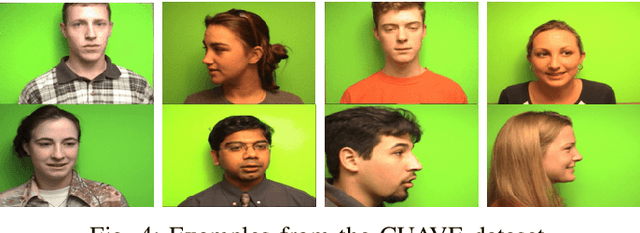
Abstract:Visual voice activity detection (V-VAD) uses visual features to predict whether a person is speaking or not. V-VAD is useful whenever audio VAD (A-VAD) is inefficient either because the acoustic signal is difficult to analyze or because it is simply missing. We propose two deep architectures for V-VAD, one based on facial landmarks and one based on optical flow. Moreover, available datasets, used for learning and for testing V-VAD, lack content variability. We introduce a novel methodology to automatically create and annotate very large datasets in-the-wild -- WildVVAD -- based on combining A-VAD with face detection and tracking. A thorough empirical evaluation shows the advantage of training the proposed deep V-VAD models with this dataset.
Extended Gaze Following: Detecting Objects in Videos Beyond the Camera Field of View
Feb 28, 2019

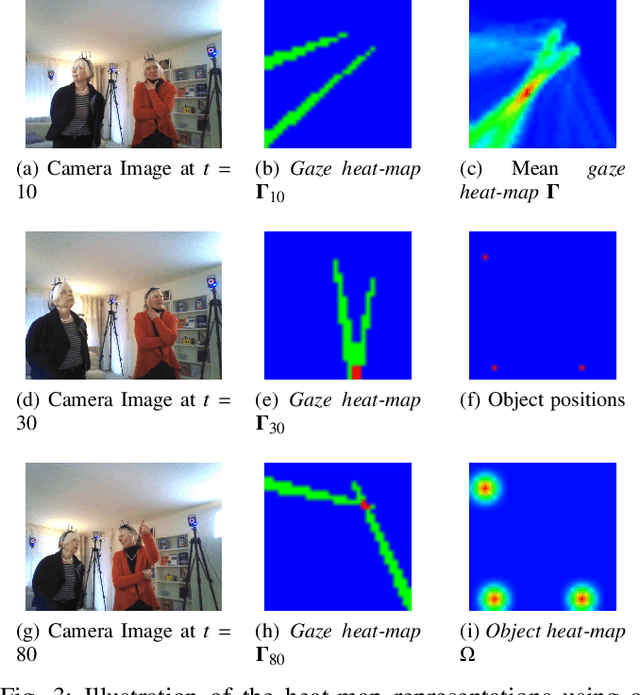
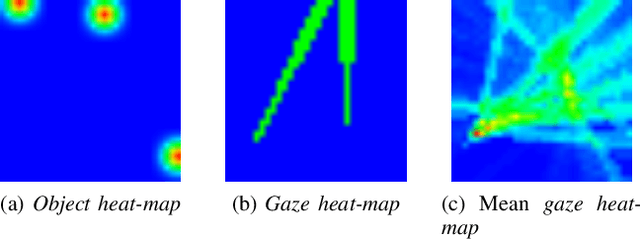
Abstract:In this paper we address the problems of detecting objects of interest in a video and of estimating their locations, solely from the gaze directions of people present in the video. Objects can be indistinctly located inside or outside the camera field of view. We refer to this problem as extended gaze following. The contributions of the paper are the followings. First, we propose a novel spatial representation of the gaze directions adopting a top-view perspective. Second, we develop several convolutional encoder/decoder networks to predict object locations and compare them with heuristics and with classical learning-based approaches. Third, in order to train the proposed models, we generate a very large number of synthetic scenarios employing a probabilistic formulation. Finally, our methodology is empirically validated using a publicly available dataset.
 Add to Chrome
Add to Chrome Add to Firefox
Add to Firefox Add to Edge
Add to Edge